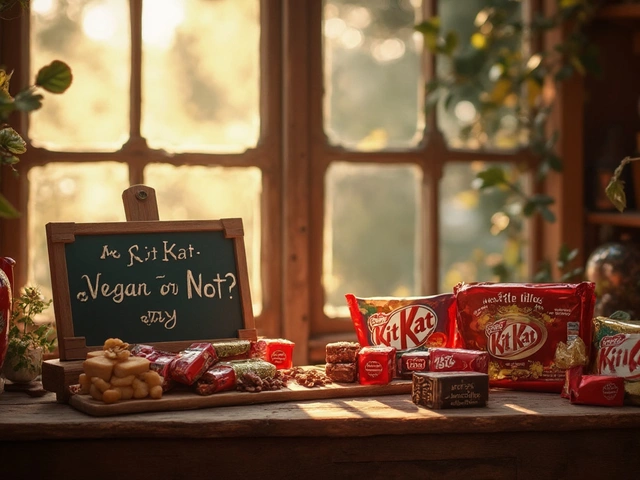
The vegan debate around Oreos isn’t just tasty gossip—it’s sparked endless group chat wars, divided friend circles, and left more than one sweet tooth confused in the cookie aisle. Imagine biting into that iconic dark disk, creamy center smushing onto your tongue, when a friend suddenly drops, “Do you know those aren’t really vegan?” Wait, what? If a classic cookie as simple as an Oreo turns out to harbor animal ingredients, what hope is there for snacks everywhere? So, are Oreos vegan? Time for some truth, not rumors.
What’s Actually in an Oreo? An Ingredient Deep Dive
Let’s get forensic with this. If you flip over a package, you’ll find an ingredient list pretty standard for mass-produced cookies. Here it is, straight from Nabisco for the classic Oreo (2025):
- Sugar
- Unbleached enriched flour (wheat flour, niacin, reduced iron, thiamine mononitrate, riboflavin, folic acid)
- Palm and/or canola oil
- Cocoa (processed with alkali)
- Invert sugar
- Leavening (baking soda and/or calcium phosphate)
- Soy lecithin
- Salt
- Chocolate
- Artificial flavor
But nothing’s ever so simple, is it?
Not every batch of Oreos or flavor is made exactly the same. In the U.S., classic Oreos don’t list milk or animal fats as an ingredient. In other countries, recipes can change—some European or Asian Oreos have milk powder or whey. Your vegan status depends in part on geography. If you travel, always double check that local packaging. Got allergies? Some countries label differently, so it never hurts to skim twice.
Another hot point: sugar. Sugar in big U.S. brands sometimes gets filtered using bone char (yep, animal bones). Nabisco doesn’t specify how their sugar is processed, so strict vegans might not be happy about that mystery. Most mainstream cookies won’t be certified vegan because of issues like these. And yes, the "artificial flavor"? Nabisco says it’s not dairy-based. If you care about every possible detail, that part is another reason to keep an eye out.
| Ingredient | Vegan-Friendly? | Notes |
|---|---|---|
| Sugar | Maybe | Can be processed with bone char. Not specified by Nabisco. |
| Flour | Yes | Vegan, wheat-based. |
| Palm/Canola Oil | Yes | Plant-based. Palm oil may have ethical concerns. |
| Cocoa | Yes | Dutch-processed, vegan. |
| Soy Lecithin | Yes | Plant-derived emulsifier. |
| Artificial Flavor | Yes | Confirmed as non-dairy by Nabisco. |
Cross-Contamination and Production: Why Vegans Still Debate Oreos
Here’s where things get blurry: the risk of cross-contamination. See that warning on the package: “May contain milk”? That little line keeps Oreos from being officially vegan. It doesn’t mean milk is poured into the batter; it means the same factory lines that handle Oreos might also crank out cookies with dairy ingredients. Picture conveyor belts, leftover crumbs, cleaning equipment that isn’t totally sterile. Milk particles could, in theory, jump across.
This is also where vegans themselves often split into two camps. Some avoid anything with any risk of cow’s milk, even at the microlevel. Others are fine as long as no animal products are actually used as ingredients. The Vegan Society (UK) lists Oreos as “not suitable for vegans” because of possible milk traces. But in the U.S., PETA’s famous “accidentally vegan” list has Oreos at the top—explaining that the cookies “don’t contain animal-derived ingredients.” It’s kind of a choose-your-own-adventure.
If you have a severe milk allergy, things are different. You really should avoid Oreos, since even a tiny bit of cross-contact could be dangerous. Oreos are neither certified vegan nor allergen-safe. For plant-based eaters who are more relaxed (or just really craving an Oreo at midnight), most folks call this cookie vegan enough. Is it perfect? No. Is it better than chocolate chip cookies with milk baked right in? Absolutely.
Vegans who care a lot about supply chain ethics—like palm oil farming or working conditions in cocoa production—may want to skip Oreos for those reasons. Nabisco does some sustainability work in their sourcing but has room to improve. Veganism isn’t just about skipping milk and eggs; it can also be about bigger issues like the planet and labor. So, eating Oreos is a personal judgment call depending on how closely you read your labels, and what veganism means to you.
Big Brands, Bold Flavors: Do All Oreos Count as Vegan?
The classic Oreo isn’t the only cookie in the game. Double Stuf, Golden, Thins, Birthday Cake, Caramel Coconut—Oreos have as many personalities as a Netflix show has plot twists. So what about all those fun flavors?
Most U.S. varieties are made using pretty much the same base ingredients. Double Stuf ups the filling, but it’s not dairy-based. Thins have a lighter crunch, but nothing risky in the mix. Weird flavors like Pumpkin Spice or Java Chip might throw in extras—sometimes colorings, sometimes “natural flavors”—so those deserve extra attention. There have been seasonal Oreos with milk chocolate bits or even marshmallow cream (which isn’t vegan due to gelatin or dairy).
Rule of thumb: flip the box around and scan for ingredients like “milk,” “whey,” “casein,” “lactose,” or “gelatin.” Most mainstream flavors are safe, but those marked “creme with milk” (often in foreign, festive, or “fudge” editions) are a no-go. Limited flavors with candy inclusions might also bring in animal products. If you’re plant-based and having doubts, Nabisco’s consumer website lists full nutritional breakdowns you can double-check before buying. Apps like “Is It Vegan?” can help scan barcodes in-store, too.
Oddly enough: some off-brand sandwich cookies are certified vegan, but the OG Oreo isn’t, thanks to the cross-contact warning. Small bakery brands have jumped at the chance to fill the certified vegan cookie gap—look for brands like Back to Nature or Newman-O’s if you crave certainty. Newer plant-based Oreo spin-offs could change the game in the coming years. And hey, Oreo even released a “gluten-free” version in 2021, but with the same animal-free ingredient list (though still technically not vegan by strict standards, due to the same factory cross-contamination).
Another thing—Oreos made outside the U.S. aren’t always the same as the stuff in American stores. Some “export” versions, especially from Asia or Europe, do include dairy or different fats. Vegan travelers should snap a pic of that ingredient label and check, because the same blue package does not mean the same recipe worldwide. Watch for writing in other languages or limited edition collab packs with candy brands.
Beyond the Cookie: Surprising Uses for Oreo Lovers (Vegan & Plant-Based)
So you’ve decided Oreos fit your plant-based standards—what now? Smash, dip, bake, blend, or crunch—Oreos are a “blank cookie canvas” for loads of vegan desserts. Here’s where you get creative:
- Oreo crust for vegan cheesecakes: Crush cookies with coconut oil for a pie crust that’s buttery without butter.
- Vegan milkshakes: Throw Oreos in a blender with oat or almond milk and a scoop of plant-based ice cream.
- Oreo balls: Mix crushed cookies with vegan cream cheese, roll into balls, and dip in dairy-free chocolate.
- Oreo brownies: Swirl chopped Oreos into vegan dark chocolate brownie batter. Texture fun with every bite.
- Ice cream toppers: Crumble on top of your favorite non-dairy ice cream flavors—cookies ’n cream, anyone?
Got friends who aren’t vegan? Serve them vegan treats made with Oreos—they seriously won’t notice the difference. Oreos are the ultimate “stealth vegan” ingredient, since almost nobody questions them unless they’re deep in the plant-based rabbit hole. If you need a quick and showstopping treat for a party (and everyone’s got dietary quirks these days), it’s tough to beat Oreos as a safe bet. If you’re in a hurry, just dip them into melted vegan chocolate and add sprinkles. Instant holiday treat.
Want to get geeky? There’s a viral trend of separating and stacking just the cookie parts for a bitter cocoa hit, or crushing just the “creme” layer for use like vanilla frosting sand. Is it healthy? Not at all. Is it awesome at midnight when your stomach is growling? Absolutely!
Vegan Verification: The Final Bite
Let’s wrap the riddle up: Classic Oreos in the U.S. don’t contain animal ingredients, but they’re not certified vegan because of milk cross-contact, and the sugar source isn’t confirmed bone char-free. So, are Oreos vegan? For most plant-based snackers, yes—unless you’re strict about cross-contamination or sugar processing.
The bottom line: Oreos are as close as you’ll get to a mainstream vegan cookie—the cookie that accidentally became a vegan legend. If you have allergies, double check. If you’re ultra-strict, you might want to hunt for certified vegan brands. For everyone else, pass the blue pack.
One last fact that still blows people’s minds: Oreos went dairy-free decades before “vegan” became a common grocery buzzword. That’s right—the beloved creamy center is, and always has been, totally eggless and milkless (it’s mostly sugar, oil, and a wild combo of emulsifiers). No marketing campaign, no social push—just pure, crunchy, creamy accident.
So go ahead—twist, lick, dunk, and ride the sugar wave guilt-free. Oreos might not be perfection in every technical sense, but in the world of vegan treats, they’re an honorary club member. Just remember, the next time you’re shoving another cookie into your mouth: you’re biting into a legend, one ingenious, unlikely, *vegan* bite at a time.








Write a comment